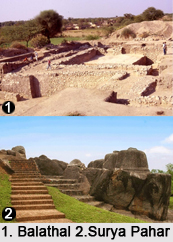 Archaeological Sites in India are the places which provide valuable information about India"s past via ancient objects. There are several such sites located in India. These sites are given below.
Archaeological Sites in India are the places which provide valuable information about India"s past via ancient objects. There are several such sites located in India. These sites are given below.
Archaeological Sites in North India
Pratisthan Pur (Jhunsi) is an archaeological site at Jhusi in Allahabad, Uttar Pradesh. It was the capital of the Lunar Dynasty. Belonging to the late Harappan period, Bargaon archaeological site is located in Saharanpur District, Uttar Pradesh. The archeological site of Kotla Nihang Khan is located about 3 kilometers southeast of Ropar city in Punjab and has links to the Bronze Age Indus Valley Civilization. Jajmau and Cemetery H are two other sites of archeological significance in North India.
Archaeological Sites in South India
Keelathooval, a village in Tamil Nadu has 6 archaeological sites namely, Ayyanar and Kali Temple, Pallivasal, Seeraaa Pallivaasal, Muniappa Samy Temple, Kudumboorani and Hero Stone. Keeladi, a small village near Silaiman on the border between Madurai and Sivagangai district became archeologically relevant when an excavation sited the presence of an ancient settlement dated tentatively, 4th century B.C. Other archaeological sites are Gudiwada Dibba, Paiyampalli, Mangulam, etc.
Archaeological Sites in Central India
Udayagiri hills and its caves are located near the city of Vidisha, northeast of Bhopal in Madhya Pradesh. Buddhist Stupas have made Deur Kothar in Madhya Pradesh famous. At Malhar in Chattisgarh many ancient temples, ancient deposits and Jain memorials have been found. Two other sites in Central India are Kaytha and Bhimbetka Rock Shelters.
Archaeological Sites in East India
Jagjivanpur is an archaeological site in Habibpur block of Malda district in West Bengal. Dihar is an archaeological site in Bishnupur subdivision of Bankura district in West Bengal. Vikramkhol is a prehistoric archaeological site located near Jharsuguda in Odisha. Some of the other sites are Chandraketugarh, Pandu Rajar Dhibi and Sankarjang in East India.
Archaeological Sites in West India
Desalpar Gunthli, located at Nakhtrana Taluka, Kutch District in Gujarat is a village and site associated with the Indus Valley Civilization. The archaeological site of Balathal is located in Vallabhnagar tehsil of Udaipur district of Rajasthan. Some of the other such archaeological sites are Baror, Karanpura and Pabumath.
Archaeological Sites in North East India
Surya Pahar, an archaeological site in Assam is a hilly terrain where several rock-cut Shivalingas, votive stupas and the deities of Hindu, Buddhist and Jain pantheon have been traced. Devtamura, a hill range in South Tripura district of Tripura has an archaeological site of rock sculptures and a panel of carved images on the bank of Gumti River. Two other archaeological sites are Pilak and Ambari.



















